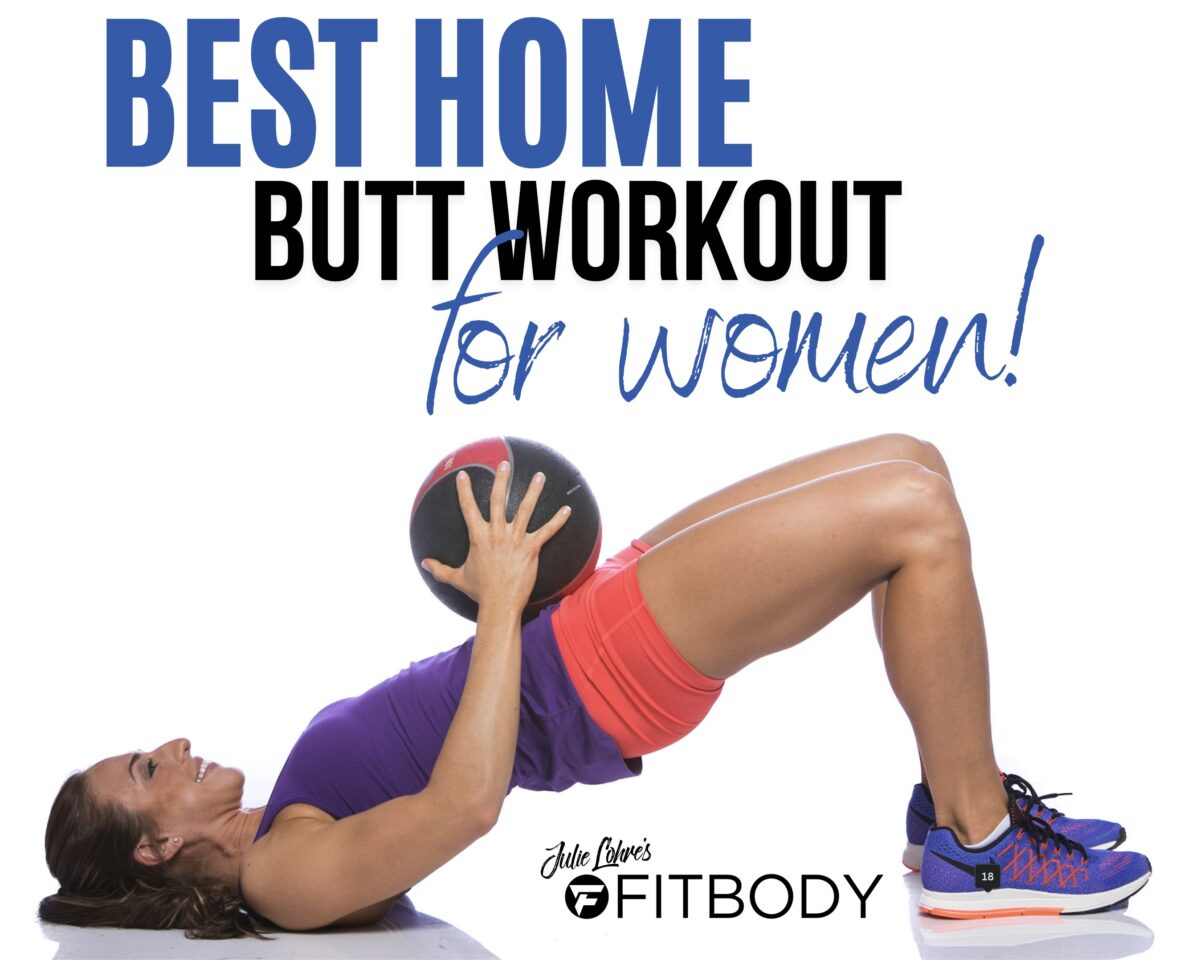Get ready to define your backside with the Best Butt Workouts for women at home!
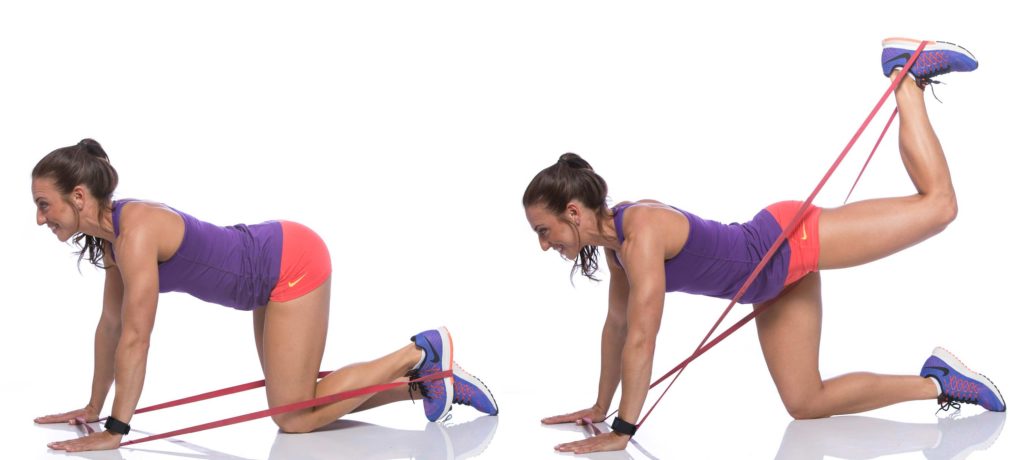
As a women’s fitness expert and online fitness coach with more than 20 year experience, I know a thing or two about creating the best butt workouts women can do at home. Great legs and a tight, round butt is something that most all women are after, but it can be difficult to find great butt workouts for women at home. Creating an amazing glute workout plan can be a tall order when many of the great butt exercises like squats and leg press require some serious gym equipment. The good news is that the exercises which best activate the glutes can be done with little to no weight!
So, I went on a mission… find the best butt workouts for women that can be done with minimal equipment out of their homes. Butt exercises that activate the gluteus maximus while still incorporating the hamstrings and quads for a full leg workout. Below you will find my favorite butt exercises. Put them together for a butt workout that will seriously activate your glutes and help your butt grow tight, round and firm in adding to you fit body as a whole!
The Significance of Strong Glutes
Experts agree that your glutes are the foundation of your body’s stability system. They play a crucial role in aligning your pelvis and maintaining proper posture, while managing the movement of your hips, legs, and core. Strong glutes also alleviate pressure on the lower back, ensuring weight is distributed evenly and preventing excessive curvature of the lumbar spine.
Enhancing the strength of your glutes is key to improving your exercise performance, as it boosts mobility. Whether it’s walking, running, jumping, or squatting, robust glutes contribute to greater power in these activities and lower the chances of injuries and muscle strains. Because your legs have some of the largest muscles in your body, when you take the time to strengthen your glutes, hamstrings, and calves, you are taking a big step forward to make your whole body stronger.
Understanding the gluteal muscles — their location and function — is vital for effective glute training. Being knowledgeable about your targets assists in selecting the most suitable exercises to achieve your fitness objectives.
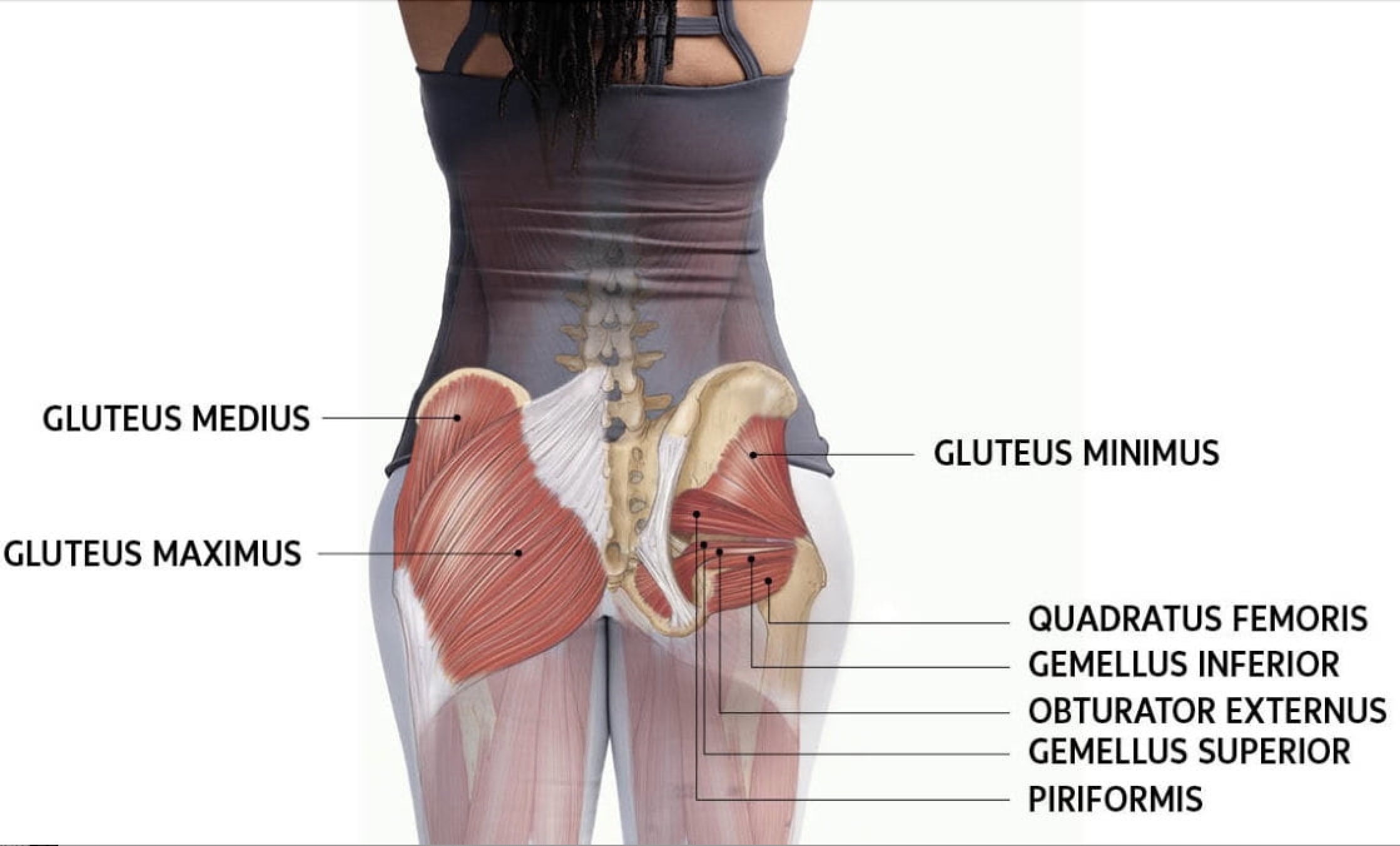
So, what muscles make up the glutes?
There are the three muscle groups that make up your glutes:
Gluteus Maximus
This is the largest portion of your glutes, with a quadrangular shape (similar to a rectangle, but in 3D). It plays a prominent role in maintaining your upper body in an upright posture and is important for pelvic alignment. It’s also responsible for the movement of the hip and thigh, whether standing up from a seated position, climbing stairs, walking, running, or lunges. Any other movement that requires straightening your leg and being in an upright position will also be supported by the gluteus maximus.
Gluteus Medius
This is the muscle lying between the gluteus maximus and gluteus minimus. It is one of the main pelvic stabilizer muscles used while standing or walking. It works in tandem with the hip to move the thigh in two directions: internally, so the knee and foot twist inward, and externally, where the thighs open away from the body, with the knees outward. Helping your body balance on one leg, it also helps absorb the force of the ground pushing back against your leg when you’re running and absorbs the force of landing, too, making it a key muscle for runners to strengthen.
Gluteus Minimus
The smallest glute muscle, it works in synergy with the gluteus medius, predominantly acting as a hip stabilizer, abducting and rotating the thigh. You’ll be engaging this muscle when you’re running, walking, doing squats, lunges, and fire hydrants. So now you know what you’re working with, you can start building strong glutes with specific butt exercises at home.
Do glutes include thighs?
Not exactly! The glutes and thighs are distinct muscle groups, each with their own unique functions. As I mentioned above, the glutes, or gluteal muscles, specifically consist of three muscles: the gluteus maximus, medius, and minimus. They’re located in the buttock region and are primarily responsible for the movement of the hip and thigh. On the other hand, the thighs are made up of several different muscles, the most prominent being the quadriceps and hamstrings. The quadriceps are on the front of the thigh and are crucial for extending the knee, while the hamstrings, at the back of the thigh, are key for bending the knee. So, while the glutes and thigh muscles work closely together to facilitate movement and provide stability, they are anatomically separate groups with specific roles in our body’s mechanics.
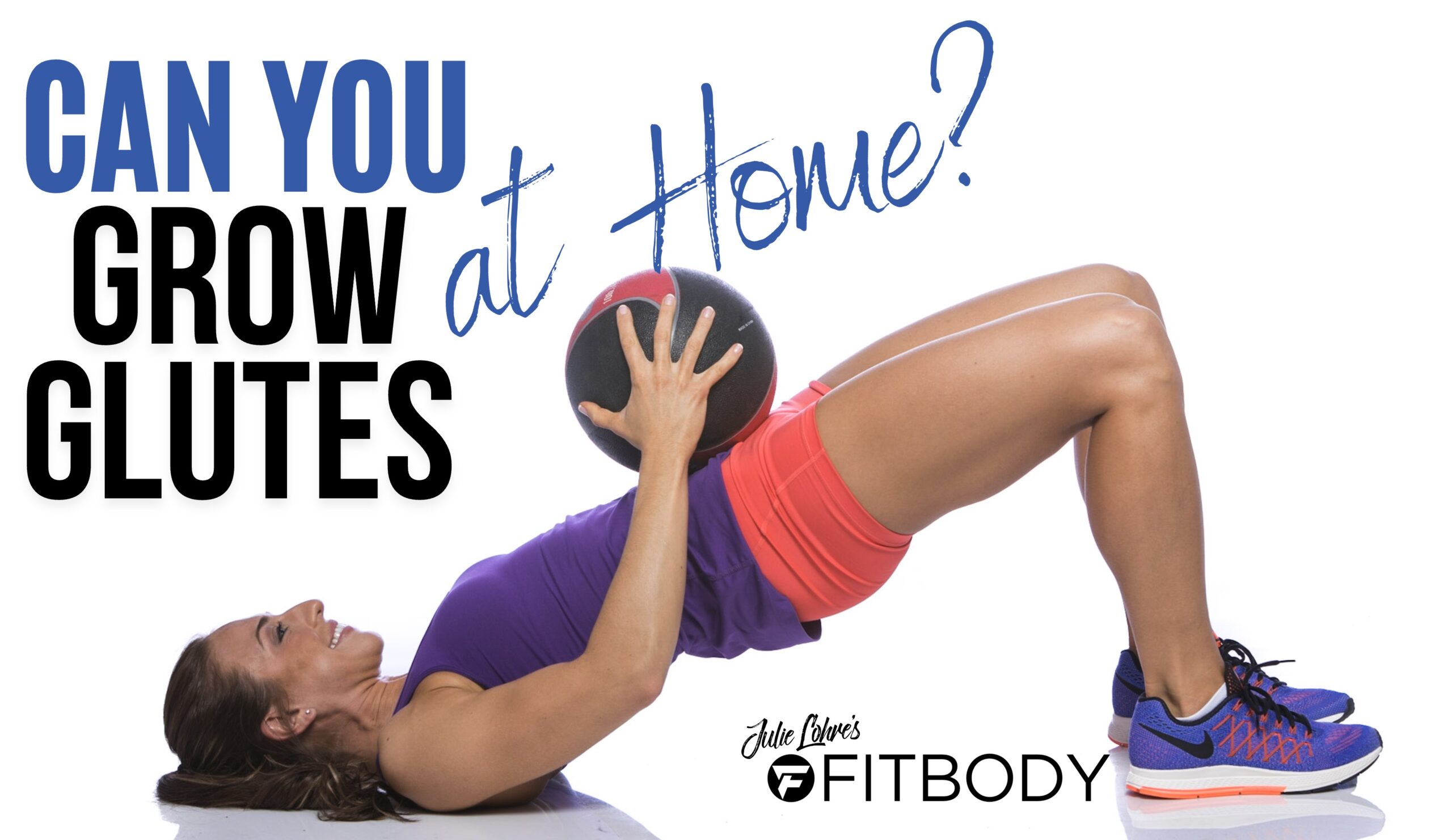
Can I grow my glutes with home workouts?
Absolutely! In my experience, you really can grow your glutes with home workouts! The nice thing about some of my favorite glute exercises is that they don’t necessarily require heavy gym equipment to be effective. The key to muscle growth, including in the glutes, lies in progressive overload – gradually increasing the resistance or intensity of your workouts over time.
At home, you can use bodyweight exercises like squats, lunges, and glute bridges, and increase their intensity by adding variations or using resistance bands. In fact, I often see the glute muscles respond well to both high-rep, lower-resistance workouts and lower-rep, higher-resistance exercises. I like to mix things up frequently. By consistently challenging these muscles in new and different ways with various exercises, while of course eating healthy and allowing time for proper recovery, you will indeed see growth and strength increases in your legs and glutes. The key is pairing great butt exercises together for the right butt workouts for women at home. As I tell my online coaching clients, consistency and progressively pushing your limits are crucial any time you aim to grow your glutes.
Butt Workouts for Women at Home
Here are my 10 favorite glute exercises that you can choose from to put together a butt workout from home. For beginners, choose 3-4 exercises to do twice a week. More advanced trainers, choose 4-5 of the butt exercises to be completed 3 times a week to really super charge your at home glute workout!
Butt Workouts for Women at Home: Best Glute Exercises at Home
X Band Walks
Sumo Squats
Single Leg Deadlifts
Banded Donkey Kickbacks
Static Lunges
Bench Step Ups
Weighted Hip Thrust
Froggy Glute Lifts
At Home Butt Workout Warm Up Exercise: X Band Walks | Lateral Band Walk
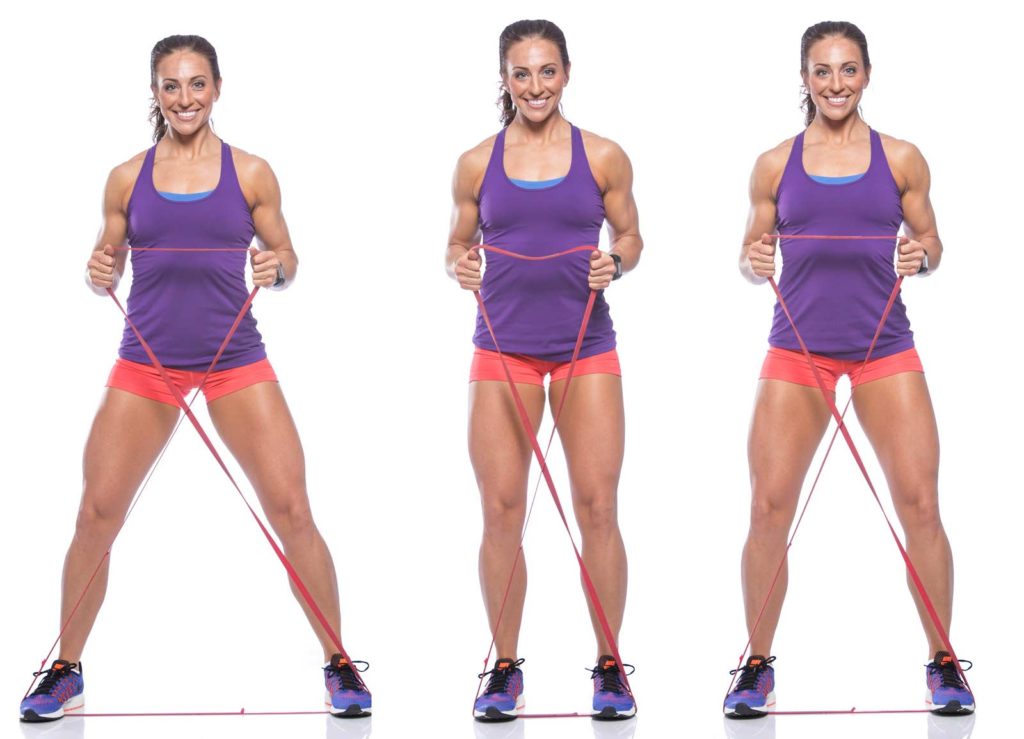
Exercising the legs and glutes at home, especially without bulky equipment, can sometimes be tricky. However, after experiencing several knee injuries, I discovered the effectiveness of X band walks or lateral band walks, thanks to a physical therapist. For over 15 years now, I’ve incorporated these exercises into both my leg workouts and those of my online training clients. This straightforward, anywhere-doable banded leg exercise is fantastic for individuals at any fitness level. It’s a practical solution for targeting the legs and glutes at home, offering an excellent workout without the need for heavy gym gear.
Butt Workout for Women at Home Exercise: Sumo Squats
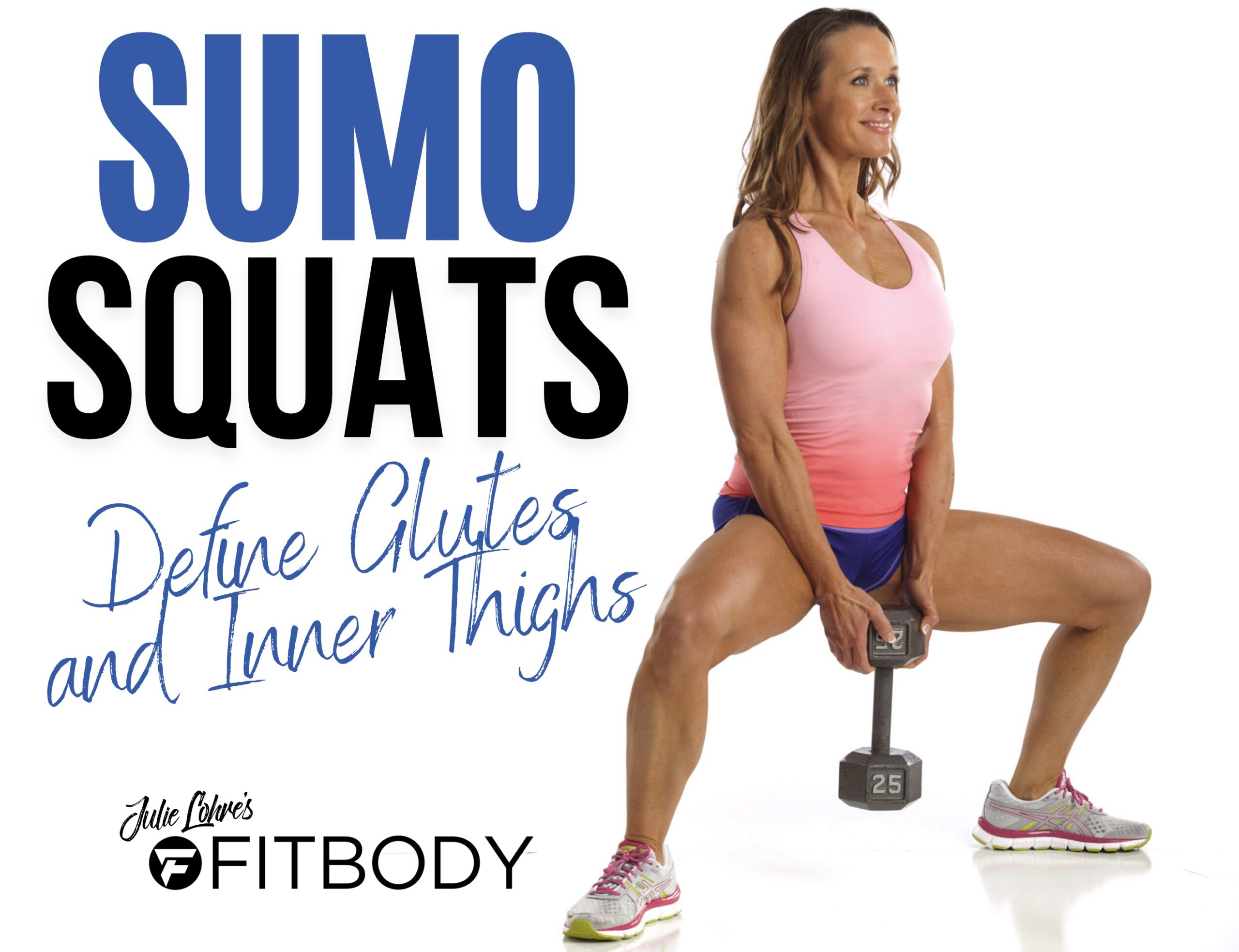
Sumo squats are an excellent glute exercise that can be easily incorporated into any home workout routine, primarily due to their effectiveness in targeting the major muscles of the lower body, especially the gluteus maximus. The wider stance and outward toe position of the sumo squat emphasize the engagement of the glutes more than traditional squats. This position allows for a deeper squat, which in turn, leads to a greater range of motion. As the glutes are required to work harder to lift and lower the body through this increased range, it results in more intensive muscle activation and development. Often called plume squats, this exercise not only helps in sculpting and strengthening the gluteal muscles but also aids in improving the overall shape and tone of the lower body, including the inner thighs and hips.
Another advantage of sumo squats is their versatility and accessibility for a home workout environment. They require no special equipment and can be performed in a small space, making them ideal for those who prefer exercising at home or have limited access to gym facilities. Furthermore, sumo squats can be easily modified to suit different fitness levels. Beginners can start with bodyweight to master the form and gradually progress to holding household items for added resistance, like water bottles or a heavy book, to increase the challenge. Additionally, the sumo squat is not just about strength; it also improves flexibility and balance, as the movement engages the core and stabilizing muscles. This combination of accessibility, effectiveness, and adaptability makes sumo squats a valuable exercise for anyone looking to enhance their glute strength and overall lower body fitness from the comfort of their home.
Butt Workout for Women at Home Exercise: Single Leg Deadlifts
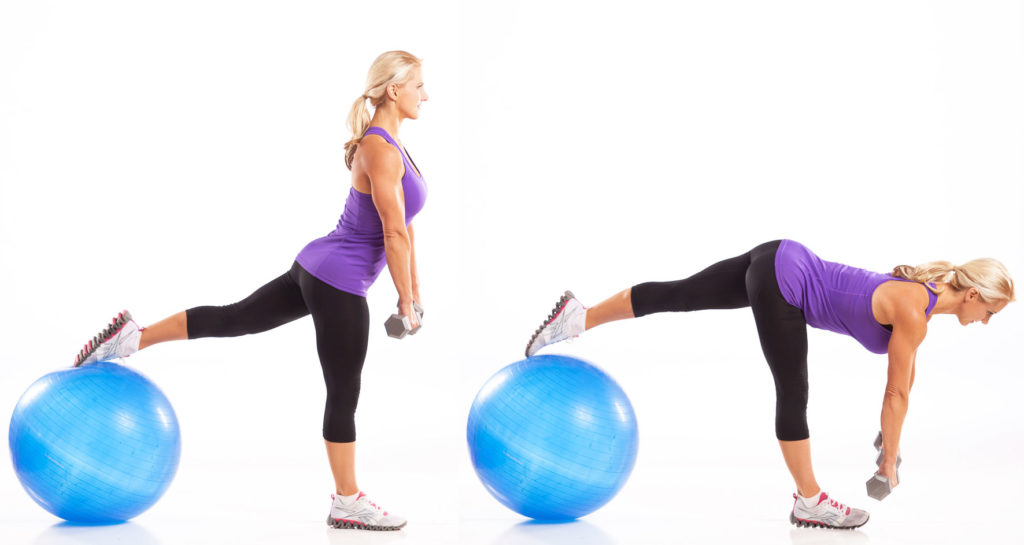
Single-leg deadlifts are an outstanding exercise for targeting the glutes, offering a range of benefits that make them ideal for home workouts. The unilateral nature of this exercise ensures that each leg works independently, leading to more balanced muscle development and greater activation of the gluteal muscles on each side. When performing a single-leg deadlift, the movement primarily involves hip hinging, a motion that deeply engages the gluteus maximus, the largest muscle in the buttocks. This focused engagement results in more effective strengthening and toning of the glutes compared to many bilateral exercises. Additionally, single-leg deadlifts also engage the hamstrings and lower back, making them a comprehensive lower body exercise that enhances overall posterior chain strength. The requirement to maintain balance and stability during the movement further activates the smaller stabilizing muscles in the legs and core, contributing to improved coordination and body awareness.
What makes single-leg deadlifts particularly well-suited for home workouts is their minimal space and equipment requirements. This exercise can be performed in a confined space and doesn’t necessarily require any equipment, making it accessible for those without a gym membership or extensive home gym setup. Beginners can perform the movement using just their body weight to focus on form and balance and they can kickstand one leg behind them instead of letting the back leg come up off the ground. As one progresses, light to moderate weight dumbbells or a kettlebell can be used to add resistance, enhancing the challenge and effectiveness of the exercise. The versatility of single-leg deadlifts also allows for variations in intensity and complexity, such as adding a knee lift or elevating the back foot on a bench or stability ball, making it an adaptable exercise for a range of fitness levels. This combination of gluteal muscle activation, balance and stability improvement, and practicality for home workouts makes single-leg deadlifts an invaluable addition to any fitness regimen focusing on lower body strength and toning.
At Home Butt Workout Exercise: Banded Donkey Kickbacks

Banded donkey kickbacks are a highly effective glute exercise that can be easily performed at home, offering significant benefits for strengthening and toning the gluteal muscles. The addition of a resistance band intensifies the exercise by providing constant tension, which ensures that the glutes are engaged throughout the entire range of motion. This continuous engagement leads to more effective muscle activation and development. The donkey kickback movement primarily targets the gluteus maximus, the largest muscle in the gluteal region, promoting hypertrophy (muscle growth) and enhancing the overall shape and firmness of the buttocks. Furthermore, this exercise also engages the hamstring and lower back muscles, making it a comprehensive workout for the posterior chain.
The appeal of banded donkey kickbacks lies in their simplicity and the minimal equipment required, making them ideal for home workouts. All that’s needed is a resistance band, which is inexpensive, portable, and can be easily stored, offering a practical solution for those with limited space or who are unable to access a gym. The exercise is also highly adaptable; by varying the resistance of the band or adjusting the number of repetitions and sets, individuals can tailor the workout to their fitness level and progress over time. Additionally, donkey kickbacks are a low-impact exercise, making them suitable for a wide range of individuals, including those who may need to avoid high-impact activities due to joint concerns. This combination of effectiveness, accessibility, and adaptability makes banded donkey kickbacks a valuable and practical choice for anyone looking to strengthen and tone their glutes at home.
Butt Workout for Women at Home Exercise: Static Lunges
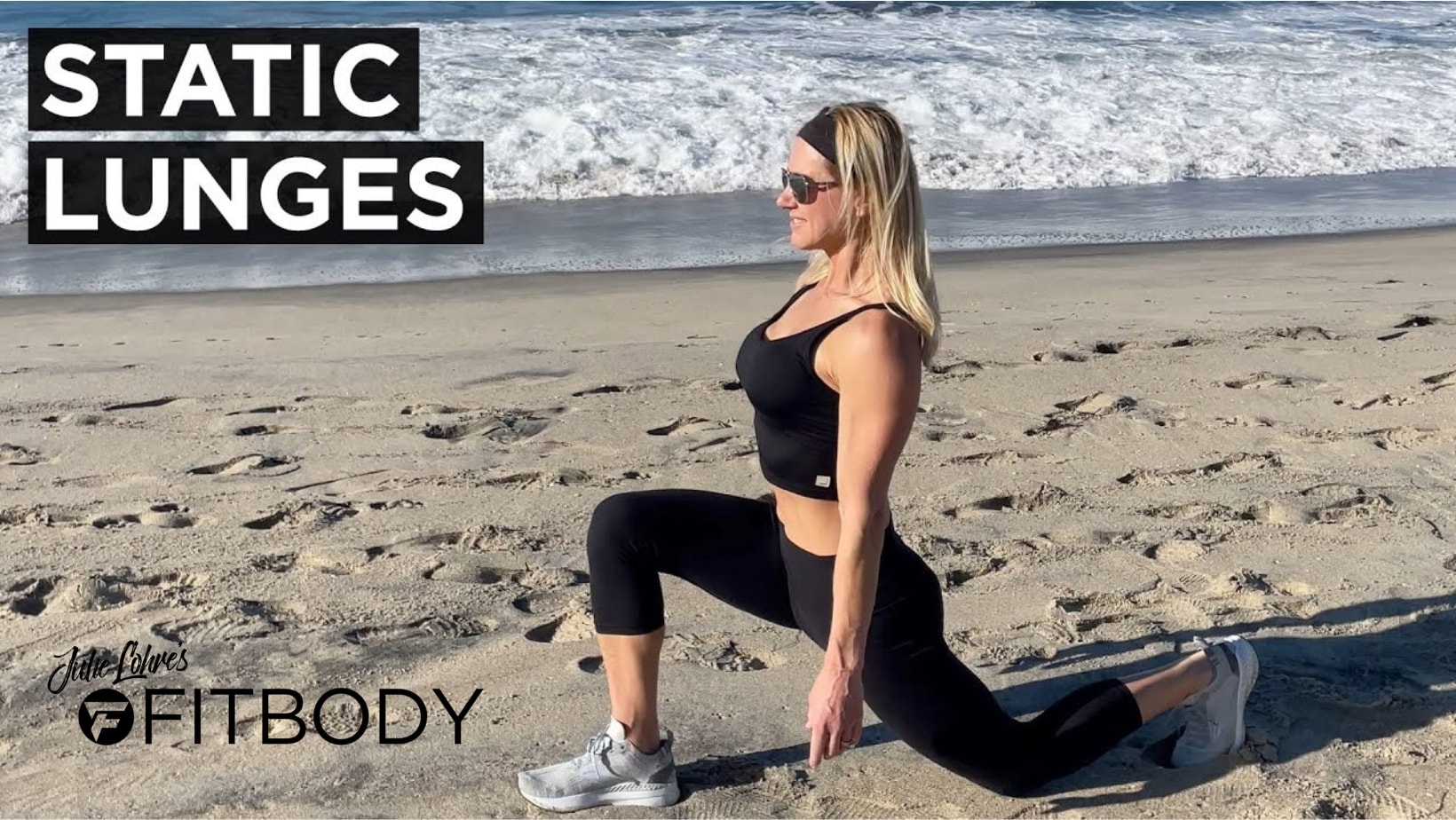
Static or stationary lunges are a highly effective glute exercise ideal for home workouts due to their simplicity and efficiency in targeting the gluteal muscles along with the entire lower body. In a stationary lunge, the split stance focuses the effort on one leg at a time, deeply engaging the glutes, quadriceps, and hamstrings. This unilateral approach ensures that each side works independently, which can help in addressing muscle imbalances and enhancing overall muscular symmetry. The stationary nature of the exercise minimizes the need for space and reduces the risk of injury due to loss of balance, making it safer and more accessible for individuals of all fitness levels. Additionally, static lunges are versatile; they can be performed with just bodyweight or intensified by adding household items for resistance, and they also promote core stability and balance. This combination of benefits makes static lunges a valuable and convenient choice for strengthening the glutes and lower body within a home setting.
At Home Butt Workout Exercise: Bench Step Ups
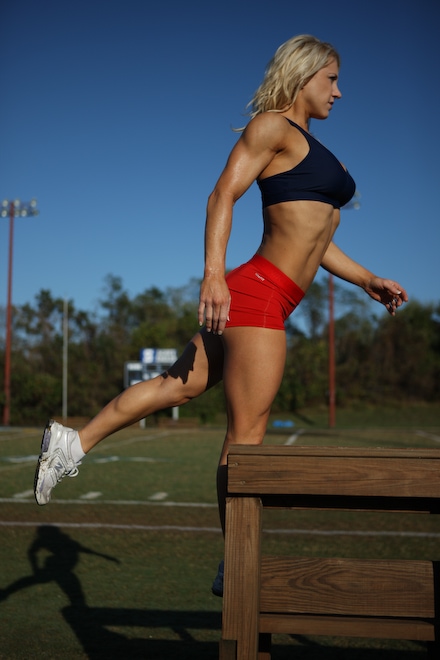
Bench step-ups are a highly effective glute exercise that can be easily performed at home, offering significant benefits for strengthening and toning the gluteal muscles. This exercise involves stepping onto a raised platform, like a bench or a sturdy chair, which forces the glutes to engage intensely as they work to lift the entire body weight against gravity. This upward motion targets the gluteus maximus, one of the largest and most powerful muscles in the body, along with the hamstrings and quadriceps, resulting in a comprehensive lower body workout. Additionally, bench step-ups are functional exercises that mimic everyday movements, enhancing not only muscle strength but also balance and coordination. The simplicity and minimal equipment requirement make it an accessible and convenient option for home workouts, while its effectiveness in activating the glutes and improving lower body strength makes it a valuable addition to any fitness routine focused on building and toning the glutes.
Butt Workout for Women at Home Exercise: Weighted Hip Thrust
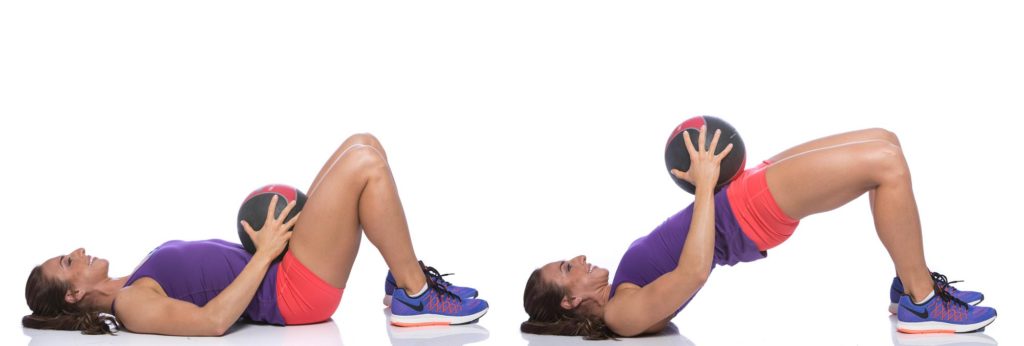
Weighted hip thrusts are one of my fav glute exercises for home workouts due to their exceptional focus on glute activation and strength development. By adding weight, such as a dumbbell, medicine ball, kettlebell, or even a heavy backpack, across the pelvis, this exercise intensifies the engagement and work of the gluteus maximus, one of the key muscles responsible for hip extension. The movement involves lifting the hips towards the ceiling while the upper back remains supported on a bench or similar elevated surface, which allows for a deep stretch and contraction of the glute muscles at the top of the movement. This action not only strengthens the glutes but also helps in improving the overall posterior chain strength, which includes the lower back and hamstrings. Weighted hip thrusts are particularly beneficial because they can be safely performed with minimal equipment and space, making them ideal for home workouts. Their ability to effectively isolate and target the glutes, combined with the convenience of being able to perform them in a home setting, makes them a highly effective choice for anyone looking to enhance glute strength and aesthetics.
At Home Butt Workout Exercise: Froggy Glute Lifts
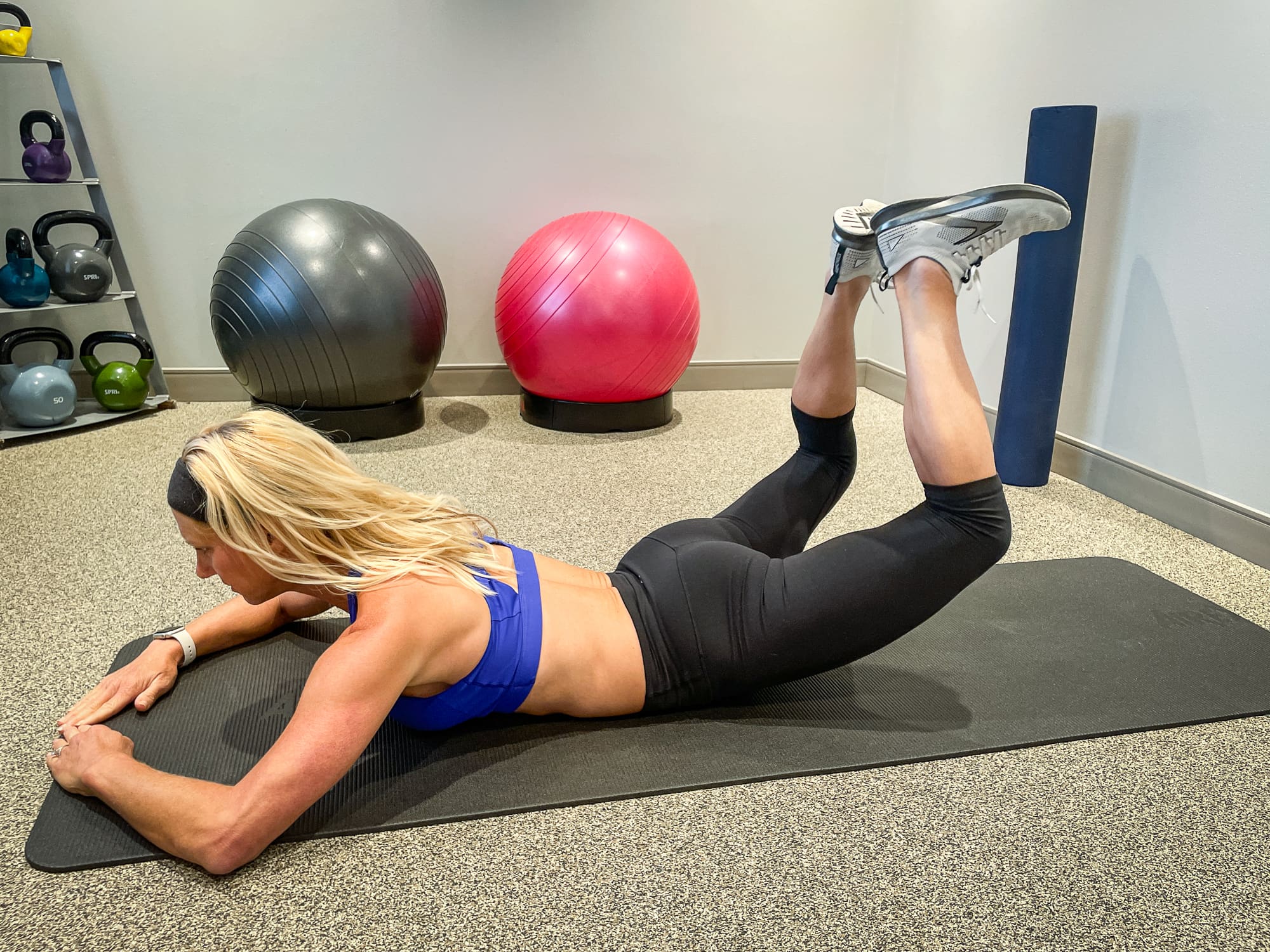
Froggy glute lifts round out my favorite at home butt workout exercises and are an excellent at-home way to target and strengthen the glutes. This exercise is particularly effective because it isolates and activates the gluteal muscles in a unique way. The position – lying on your stomach with the soles of your feet together and knees splayed out, mimicking a frog’s legs – ensures that the glute muscles are engaged throughout the entire movement. Unlike traditional glute exercises that might also heavily engage the thigh muscles, froggy glute lifts specifically focus on the gluteus maximus, medius, and minimus. This targeted activation is key for developing strength and shape in the glutes. Additionally, this exercise engages the low back without putting strain on the knees, making it suitable for people of various fitness levels and those with joint concerns.
One of the biggest advantages of froggy glute lifts is their convenience for home workouts. They require no equipment and very little space, allowing them to be easily incorporated into any home fitness routine. This makes them an ideal choice for those who may not have access to a gym or prefer the comfort and privacy of working out at home. When combined with other effective at-home exercises like sumo squats, froggy glute lifts can help create a well-rounded glute workout, targeting all areas of the buttocks for comprehensive strengthening and toning.
Enhancing Your Glute Workout: Essential Tips
Having the right mindset plays a pivotal role in reaching your glute workout objectives. I like to think of your mind as your strongest muscle, especially when working out at home. It’s the mental push and mind-muscle connection that initiates the physical effort in exercises like sumo squats or hip thrusts and ensures you are feeling it in the right places.
Here are a few strategies I have found helpful when trying to maximize your glute workouts.
- Warm-Up Routine: Start with one or two lower-body warm-up exercises to prep your glutes for more intense activity.
- Gradual Rep Increase: For beginners in home-based glute workouts, begin with fewer repetitions and gradually increase them as your strength builds. The number of reps should align with your fitness goals, ensuring you work each glute muscle effectively and increase weight and intensity over time.
- Prioritize Proper Technique: Good form is crucial. When doing any type of exercise be mindful of your overall posture and muscle engagement. Proper alignment and form will allow you safely and effectively complete butt workouts at home.
- Engage Your Core: Always activate your core muscles during glute exercises.
- Exercise with Caution: Stop any glute exercise immediately if you feel pain.
- Adapt as Needed: Respect your body’s limits. Modify or avoid certain glute exercises if you’re recovering from surgery, dealing with back, abdominal, knee, or ankle issues, or if you’re in the late stages of pregnancy or have recently given birth.
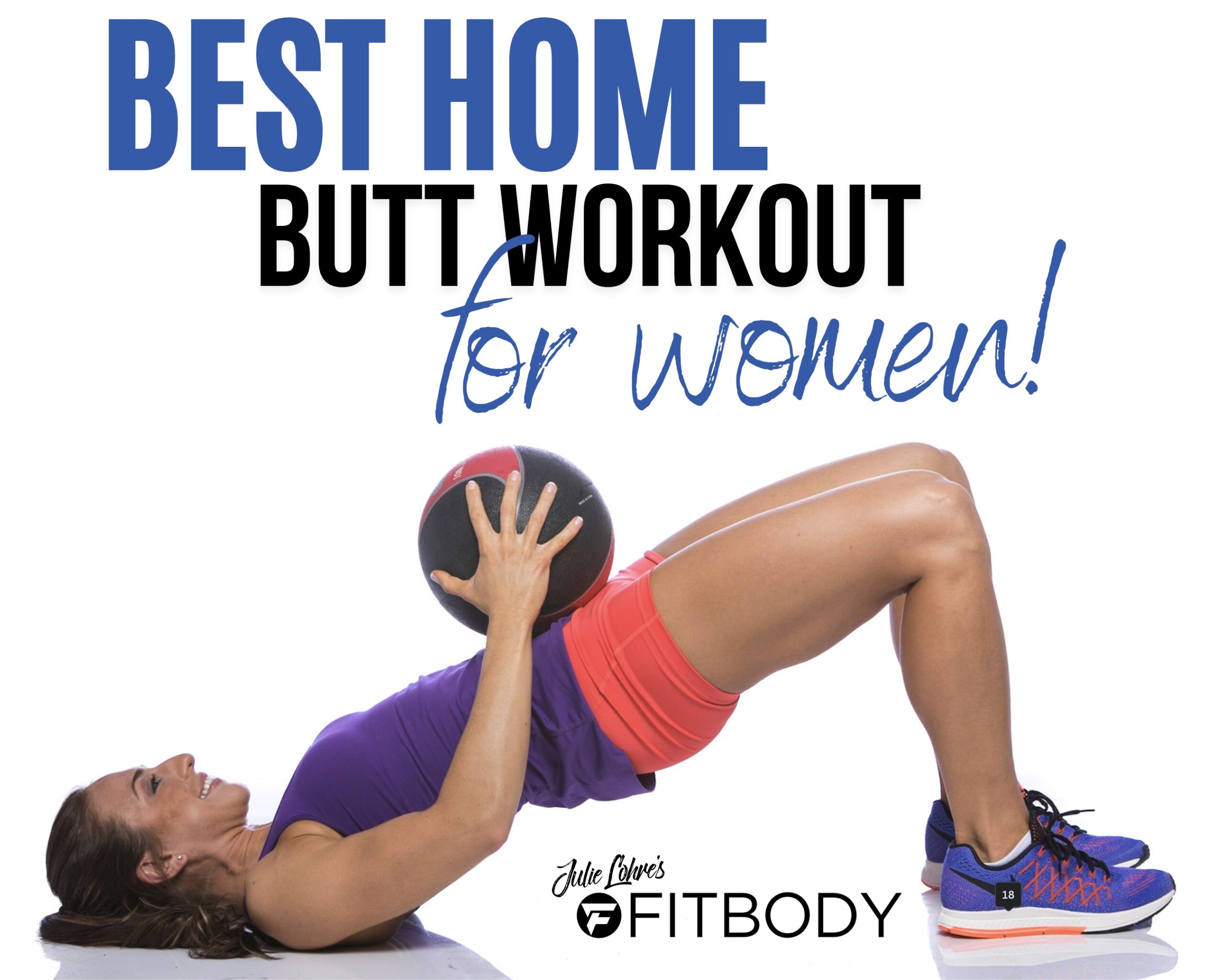
Benefits of Home Glute Workouts for Women
Glute exercises are beneficial for everyday life. Customizing these exercises to your individual condition and goals offers several advantages.
Improvement in Posture: Strong glutes are essential for stabilizing your body. They keep your pelvis and hips aligned, ensuring an even distribution of weight across your body. This alignment supports the natural curve of your spine, contributing to better posture and movement, including the alignment of your shoulders and neck. During movement, glutes act as the primary force for propulsion in activities like walking or running. They are part of the posterior chain, which includes the muscles at the back of your legs and spine, and they provide support even when standing still. If your glutes are weak, other muscles, such as the hip adductors and hamstrings, might compensate, leading to misaligned movement mechanics. This can result in discomfort or strains in the hips or legs.
Enhancing Agility: Strong glutes support daily activities, improve posture and strength, and also boost agility, especially in activities like running or tennis. They facilitate quick changes in direction. Each glute muscle, particularly the gluteus medius, plays a role in providing power and stability during these movements. Glutes also play a key role in other forms of exercise, from balancing in yoga to core strengthening in pilates.
Strengthening the Back: Chronic lower back pain is a widespread issue. Engaging in exercises that stretch and strengthen the tissues around the lower back can alleviate this pain. Glute workouts are particularly effective, as they have been shown to strengthen lumbar muscles, reducing lower back pain and injury risk.
Injury Prevention: During Workouts The gluteus maximus is crucial for pelvic and hip stability. It connects to the iliotibial (IT) band, which extends from the hips to the shins. Strengthening the glutes provides additional support for hip extension, abduction, and rotation.
Boosting Core Strength: Core muscles include those around the spine, hips, and stomach, such as abdominal and lower back muscles. Engaging your glutes during exercises also strengthens your core, which is fundamental for daily activities. A strong core allows for progression in workout intensity and ensures proper form and posture. Incorporating lower body strength training into your weekly exercise routine can significantly enhance your overall fitness. This approach lays a solid foundation for a stronger, healthier body.
Find out more about Online Personal Training with Julie


